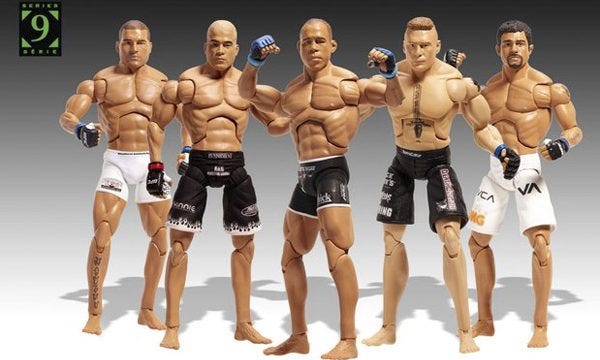Neal's Fight Island MMA rankings
Neal provides his rankings for March 2023
Fight Island is going to maintain rankings.
We’re not yet certain how they’ll look in the end, but we’ve agreed in principle on a few points.
1) They’ll be an aggregate format with contributors each producing their own list.
2) Contributors will use their own explicit ranking criteria.
3) We will share eligibility criteria. For now these are those criteria:
a. Fighter has made weight in the division in the last 12 months.
b. If fighter has a fight booked when those 12 months elapse they will not be removed from eligibility.
c. Fighters will be classified by actual weight on the scale, division names and other promotional eligibility criteria notwithstanding.
4) These rankings will occasionally be accompanied by discussion articles.
5) We’re not going to waste effort on pound-for-pound discussion, because it’s made up, meaningless, and arbitrary.
This is the first of those discussion articles: I will share my initial world MMA rankings as of UFC 285 and Bellator 291, and I will discuss the criteria I used to get there.
First: the numbers. Take the time to find something that you disagree with. Discussion to follow.
Men’s Rankings
125 Lbs.
Brandon Moreno
Deiveson Figueiredo
Alexandre Pantoja
Kai Kara-France
Brandon Royval
Matheus Nicolau
Manel Kape
Amir Albazi
Alex Perez
Muhammad Mokaev
135 Lbs.
Aljamain Sterling
Merab Dvalishvili
Marlon Vera
Sean O'Malley
Petr Yan
Cory Sandhagen
Patchy Mix
Ricky Simon
Demetrious Johnson
Raufeon Stotts
Kyoji Horiguchi
Pedro Munhoz
Magomed Magomedov
Adriano Moraes
145 Lbs.
Alexander Volkanovski
Max Holloway
Yair Rodriguez
Arnold Allen
Ilia Topuria
Movsar Evloev
Patricio Pitbull
Fabricio Andrade
Brian Ortega
Josh Emmett
Calvin Kattar
Bryce Mitchell
Jung Chang-sung
Shane Burgos
155 Lbs.
Islam Makhachev
Charles Oliviera
Beneil Dariush
Rafael Fiziev
Dustin Poirier
Justin Gaethje
Usman Nurmagomedov
Michael Chandler
Mateusz Gamrot
Arman Tsarukyan
Jailin Turner
Mansour Barnaoui
Brett Primus
170 Lbs.
Leon Edwards
Kamaru Usman
Khamzat Chimaev
Gilbert Burns
Shavkat Rakhmonov
Yaroslav Amosov
Belal Muhammad
Jack Della Maddalena
Logan Storely
Steven Thompson
Christian Lee
Geoff Neal
Sean Brady
Vicente Luque
Jason Jackson
185 Lbs.
Alex Pereira
Israel Adesanya
Robert Whittaker
Johnny Eblen
Jared Cannonier
Roman Dolidze
Dricus du Plessis
Brendan Allen
Derek Brunson
Jack Hermansson
Sean Strickland
205 Lbs.
Jiri Prochazka
Jan Blachowicz
Magomed Ankalaev
Jamahal Hill
Vadim Nemkov
Corey Anderson
Johnny Walker
Phil Davis
Nikita Krylov
Ryan Spann
Heavyweight
Francis Ngannou
Curtis Blaydes
Jon Jones
Sergei Pavlovich
Ciryl Gane
Tom Aspinall
Sergey Spivak
Alexander Volkov
Marcin Tybura
Jarzinho Rozenstruik
Jailton Almeida
Alexander Romanov
Ryan Bader
Linton Vassell
Women’s Rankings
Note that the two premiere Atomweight divisions – RIZIN and Invicta – use 108lb and 105lb as the cutoffs respectively. Due to a shortage of notable fighters to populate the list, I have combined these as a -108 division.
108 Lbs.
Seika Izawa
Jillian DeCoursey
Jessica Delboni
Si Woo Park
Ayaka Hamasaki
115 Lbs.
Zhang Weili
Amanda Lemos
Marina Rodriguez
Carla Esparza
Rose Namajunas
Yan Xiaonan
Mackenzie Dern
Virna Jandiroba
Angela Lee
Stamp Fairtex
Angela Hill
Tabitha Ricci
125 Lbs.
Alexa Grasso
Erin Blanchfield
Valentina Shevchenko
Taila Santos
Manon Fiorot
Jessica Andrade
Xiong Jing Nan
Kaitlyn Chookagian
Casey O'Neill
Jennifer Maia
Lauren Murphy
Liz Carmouche
Maycee Barber
Miranda Maverick
Amanda Ribas
135 Lbs.
Amanda Nunes
Juliana Pena
Raquel Pennington
Irene Aldana
Holly Holm
Mayra Bueno Silva
Ketlyn Vieira
Pannie Kianzad
Sara McMann
Karol Rosa
The first thing you will probably notice is that I don’t yet have a full top-15 for all divisions. This will take time as it turns out that making a comprehensive ranking is hard, especially if you care about what you’re saying. After a certain point the division can become white noise. There are more than 10 light heavyweight fighters in the world, granted, but those fighters who are not as good as Ryan Spann seem like an amorphous blob right now. More fighters will fill those holes as fighters distinguish themselves.
And now here’s how I arrived at these numbers.
Criterion #1 Descriptive rankings
When I rank fighters, I do so by past, observable performances. This seems obvious, but if you pay attention to the way that MMA fans discuss the concept of rankings, you’ll notice that much commentary depends on a predictive view of the sport and hypothetical matchups – i.e. “fighter A should be ranked above fighter B because I think A would win.” Similarly, the actual win or loss on the record is what we can observe. I may disagree with a decision or result, but in the end the sport of MMA is about achieving wins within given competitive framework, which includes convincing shitty judges to award rounds. I can not rank based on counterfactuals such as “had Chris Lee not been cageside...”
Criterion #2 Wins push fighters up; losses push them down
Winning fighters go higher in the rankings. Under no circumstance will a fighter ever be ranked above an opponent who beat them in the last outing. This is why Valentina Shevchenko is above Taila Santos today, and why Alexa Grasso is above Valentina Shevchenko. In my mind, no fighter coming off of a loss to anyone other than the champ should be top 5, no fighter with two consecutive losses should be top 10, and no fighter with three consecutive losses should be ranked at all. (I’m sorry, Derrick.) This won’t be a hard rule, (see Petr Yan at #5) but this can explain many heterodox decisions.
Criterion #3 Consistency matters
A fighter who has alternated wins and losses against top-5 competition will be ranked below a fighter who has a streak with wins against fighters 6-10. When making decisions about how far to push a fighter in a loss, I will often look to their last win against a currently ranked fighter. I genuinely think of this as the Michael Chandler rule – his last win against a fighter who I now have ranked was in 2018. Even though he’s a main event fighter, he’s not a winning one, so he falls below consistent winning fighters like Dariush and Fiziev.
Factors not on this list – such as who holds a given belt or lineal championship – are secondary. Readers are welcome to disagree with my rankings, but if you choose to do so, please consider my rankings in the light of these three criteria. I’m not interested in other people’s gut feelings as my own are hard enough to sort out.
Qualitative tiebreakers
Once wins and consistency are satisfied, I weigh factors like dominance of wins, opponents’ performances, performances in other divisions, and general MMA Math. There will be times where I make a call based on the fighter’s attributes that I saw in the cage on a given night. I had Amosov ranked at 5 before UFC 285, but Shavkat (previously at 6) showed ability to overcome opposition and thus switched spots, even though there was no movement in their relative records or shared opponents. It was a call; I made it. There will be times where a fighter who I like gets preference in these tiebreaker moments (Merab Dvalishvilli and Patchy Mix, perhaps?).
There it is: the first Fightis.land World MMA Ranking post. Remember, this is merely the first post in a series which will aggregate multiple lists in a format to be determined.
More to come.






